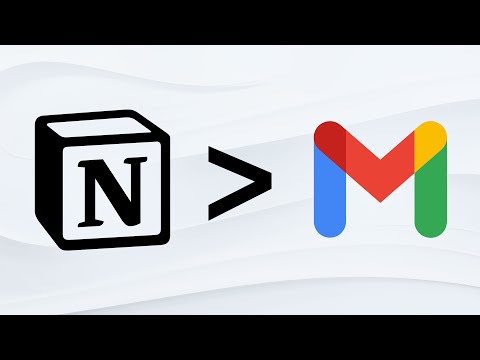Notion Mail Just Launched—And Gmail Isn't Even Close

For the past 20 years, one tool has been fundamental to business, yet has evolved the least: Email. While we have smartphones, AI, and increasingly advanced computers, it feels like Email is exactly where it was 20 years ago. But that might be changing. Notion has just taken a huge step with Notion Mail, and I think this is the evolution we’ve been waiting for. I wanted to learn the “Why” behind it. So, I talked to the team behind Notion Mail and even one of Notion’s founders to learn how it works and the philosophy behind it.
Surprisingly, this goes very deep. Here’s what they had to say. If you aren’t familiar with Notion, it’s a suite of customizable productivity tools, but at it’s core, its building blocks for software. Hence their logo Everything in Notion, be it text, headers, code, or tables, is considered “blocks”, which can be dragged, nested, stacked, re-ordered, or transformed. Not’s not just vertically, but horizontally. From CRM software to to-do lists, to databases, to writing flowcharts, to wikis. The inspiration for this is Legos. This is Akshay Kothari, the COO and Cofounder of Notion.
Notion is like a box of Legos. The same pieces, which let you build what you want, like a plane or a spaceship. In the case of Notion: A tool to create tools. But, this idea of “Lego software” is not just about customization, but something even more profound. The idea draws from the work of Douglas Engelbart, the founding father of computers, who invented the Computer Mouse itself: In his 1962 paper, he details a fascinating perspective on software. A number of people maintain stoutly that a practical augmentation system should not require the human to have to do any computer programming. Well, that translated to a home workshop, would be like saying that you can't
require the operating human to know how to adjust his tools, or set up jigs, or change drill sizes, and the like. You can see there that these skills are easy to learn in the context of what the human has to learn, and that they provide for much greater flexibility in finding convenient ways to use the tools to help shape materials. What Engelbart is saying here, is quite contrary to the world of computing, that there shouldn’t be a difference between “Builders” and “Users”. That users should be able to build and design software, system, and use design tools by themselves, for themselves.
There are, of course, the explicit computer processes which we use, and which our philosophy requires the augmented man to be able to design and build for himself. Akshay and his co-founders saw the potential for what software could be. But early on, they had a huge problem. The average person just
didn’t care. Tension Notion’s founders were passionate about this tool. But they couldn’t get people to buy into their vision.
It didn’t quite have product market fit. Then, they had an idea. The breakthrough moment was not the value, but the way customers received and interacted with it. “Sugar Coated Broccoli” is the idea of attracting customers with something sweet, but the real vision and value is hidden beneath. A productivity tool, hiding what is essentially a programming language tool, to build your own tools! Going back to the original idea of Notion, I think this is just like Lego Sets.
You buy a box, be it Lego Star Wars or Lego City, which looks a very specific way. But if you’ve used Legos, you know the best part is the freedom to build what you want, forever, with those pieces. I think this is what Notion did. They hid their unlimited potential inside something easy to understand and use: Productivity software and a strong document tool. Sugar-coated Broccoli. But Notion wasn’t out of the woods just yet.
The vision was there, but building it out was another story. Creating such a dynamic, novel platform is difficult, especially when the technology doesn’t necessarily exist just yet. This means, you have to make some bets, but sometimes, they don’t pan out. In the early 2010s, Notion was built using Google Web Components. But, this brought a lot of problems.
Notion was back to stage one. Even though they figured out their philosophy, this was a huge setback. Long term, it was the right move, but there was a question on Ivan and Simon’s minds. “How are we going to survive this setback?” Notion weathered the storm, and was working towards a long term vision. And soon, after a lot of work, that vision came to life.
With all of these hard learned lessons, in August 2016, Notion was relaunched on Product Hunt, and immediately started gaining momentum. Within a year, Notion hit a million users. But there was something interesting going on. 80% of these users were outside the US, and all of them, came from word of mouth. People in major companies began to tinker with Notion. DoorDash, Nike, McKinsey, even Adobe’s Chief Product officer.
These weren’t enterprise solutions either, it was just… Notion. Then, it happened. Tutorials on how to use Notion began to blow up. Notion was flooded with users, millions of them, and fast. Quickly climbing to 20 million users. Yet, ironically, this brought about Notion’s biggest challenge.
Not only was it so much demand, but they couldn’t scale their infrastructure With little time remaining, they managed to get things under control. But, there’s still one looming question: Why did tutorials for Notion blow up of all things? It sounds strange, since these are tutorials, but it comes back to Notion’s philosophy of Lego blocks. People were discovering how powerful and customizable Notion was. With it’s building blocks, you could tailor it for your workflow down to the finest detail.
And now, with modern day Notion, this is even more the case. They’ve integrated Notion calendar, and soon, Notion AI”. But it’s not just any regular AI add-on like so many other products. Since Notion is built in blocks, you can ask it to setup a workspace, database, sprint, or anything you can describe. Notion is powerful, because it’s essentially tied
to your own imagination, like Lego. And that, brings us to Notion Mail. It feels like so much of tech has advanced, and Email has stayed where it is. It’s used by billions of people, and this has caused a few consequences.
For one, email feels as universal and broad as it possibly can. That might sound like a selling point, but when something is just standard for the masses, it’s hard to make it your own. Not only that, in our amazing modern world with AI, organizing your inbox is very time intensive. It often feels like literally labelling physical letters and chucking them into different piles.
I mean, it’s why my email is a much bigger mess than it should be. But many people can’t afford that. Email is where almost all their business takes place, yet it seems medieval. Notion Mail brings a big solution to this. “Auto Label”. This feature is unbelievable. If you click the “Auto Label” button, then describe a type of email, say “Restaurant reservations”, Notion AI will review your inbox, find the emails that fit your prompt, then auto label them. That’s it.
No need to create a custom label and go through your emails to label them manually. For obvious reasons, this is amazing. This is what I imagined an AI assistant, actually doing. But we’re just getting started. When you open Notion Mail, you might just see your standard Gmail inbox, with things of all kinds of priority lumped together. But with categories, you can organize them based on your workflow, not just chronologically.
Notion Mail is just like the rest of Notion: Legos. You decide what your inbox is like, not the other way around, and it’s taken even further with Properties. If we click settings in the top right, and properties, we can overhaul our inbox, and quickly. I can hide the category, body, and if I want, everything except the subject to make it as concise or as detailed as necessary.
This comes into play with “Views”, which are your custom workspaces with these labels. I might need the subject, body, and more for important emails, but only the subject for promotions. This sounds like some fun customization, but it’s seriously powerful.
Notion already has a large collection of View templates to quickly setup your inbox, like News, Social Media, or Bookings. You can build Notion Mail to centre around your own workflow, instead of changing your workflow to fit with a standardized system someone else made for you and a billion other people. Notion Mail is built for this, not just being email but a productivity tool. There’s also a ton of quality-of-life improvements that just make the user-experience easier. For one, hovering over emails gives you a small preview. Or you can adjust the email pop out to
be on the right, overtop, or the whole page. The core of Mail, like the rest of Notion, is a tool, to help you build a tool. But before we get to more of that, what about the actual emailing? The sending, writing, and replying? Your email view will look very familiar, and has the standard functions you’d expect, as well as the “improve writing” function. But there’s also something I’m really excited about. If you use Notion, you know the writing system is amazing, part of that, comes from the “/” command, which brings you a long, long list of functions, instantly. This is huge. It feels like we’re finally in the 21st century, yet, this goes even further than presentation. Just type “/”, scroll to “schedule” You can schedule a meeting inside your Notion Calendar, then send the proposed meeting, and the recipient can confirm.
Normally, I would have to grab a link from an external tool and paste it in, but it’s built into my email client here. This shows us what Notion is really trying to do. Having a new Lego set is fun, but when you get to add it to a big pile of Legos, is when you get magic. That magic is what Notion is trying to create. Integrating email, where so much of our work and even life happens, into Notion has incredible potential. What Notion Mail is really doing is
breaking down software to the core building blocks, and allowing you to put them together, however you want. All of this, weirdly, makes email fun. Even as someone in business, emailing is the least favourite part of my workflow. I generally stick to Discord, Slack, or iMessage whenever I can. But with
Notion Mail, the entire concept of email is a lot more appealing. It’s feels like that magical step of going from old word docs to Notion all over again. Personally, I can’t wait to see how Notion Mail and Notion as a whole evolves. I wish the best of luck to Andrew, Akshay, and the entire team at Notion, but until then, I’m Hari, and I’ll see you guys in the next one.
2025-04-19 21:45


